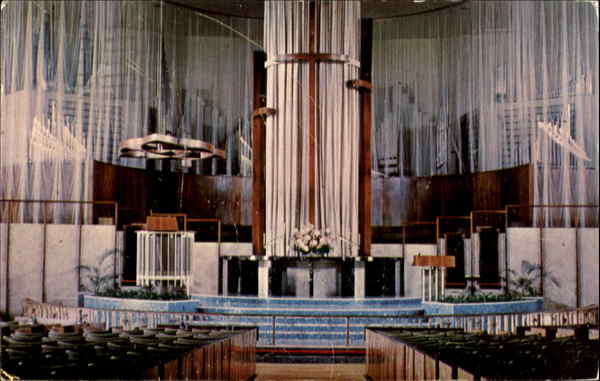She was 11, she calculated, so her brother was 7, and I was the same age. Their sister would have been 2. My brother and sister, twins, would have been four. Her father, my Uncle Lloyd, was a Methodist minister (whom I still respect greatly to this very day). Our family was visiting theirs. Uncle Lloyd had just been assigned a congregation in suburban Oklahoma City. He told my parents about two new church buildings in the area that they really ought to see.
So both families piled into our huge befinned cars–the year was 1958–and we went for a drive. First we stopped at the Church of Tomorrow, which I described on Friday, and we went inside. As the adults discussed the fine points of the architecture, my cousin and I were running up and down the aisles chasing each other. The younger kids were being noisy. (I’m sure Sharon was well-behaved, as always.) Our parents would have tried to rein us in, but rowdy kids are a headache, so we soon left.
Then we went to another new church building, built around the same time, St. Luke’s Methodist Church. Whereas the architect of the so-called Church of Tomorrow was trying to design everything so that it seemed new, modern, and futuristic, the architect of St. Luke’s was trying to do a modern take on traditional church design. Like a cathedral, the sanctuary was lit by stained glass windows and had a soaring ceiling. The eye was drawn immediately to the central altar, above which were three towering crosses. The pulpit was elevated and above where the pastor would preach floated something like a nimbus. The lines in the sanctuary–from the structural elements, the draperies, the decorative details–were all vertical, all pointing upwards, creating the sense of transcendence.
As Sharon tells it, when we rambunctious kids went into the sanctuary, we stopped in our tracks. We became completely silent. We stopped playing. We didn’t move. At that young age, we were in awe.
Uncle Lloyd commented, “See what a sense of the sacred can do.”
That the sense of transcendence communicated by this church art and architecture got through even to young children who had little inkling of what any of it meant is very telling. There are aspects of Christianity that are not just about intellectual knowledge and rational comprehension of ideas, nor are they emotional, as such, though they are experiential: the sense of mystery, a perception of holiness, the response of reverence. Even children can recognize them, and adults would do well to cultivate them. And a genuinely religious art and architecture should aim at evoking them.
What did it mean that the second-grader that I was then was completely unaffected by the Church of Tomorrow–though its space-age style was supposed to appeal to the younger generation when we grew up–and yet I was deeply moved, even then, even so young, at St. Luke’s?
I have always treasured experiences of awe, of the sublime, and perhaps this has been part of my personality even as a child.Was my response an indication that I would eventually look for a kind of Christianity that was richer, more mysterious, and more aesthetically powerful than that of the bland, liberal mainline Protestantism I was brought up in, an alternative that I found in Lutheranism? But not everyone with me then went on a similar journey.
I’m not saying that children are necessarily going to be better behaved in one kind of church setting over another, but it would still do them good to be exposed to a setting that elicits reverence.
Now it’s true that Methodists too, like the Disciples of Christ, are a mainline Protestant denomination, and they too have become liberal in their theology (at my uncle’s resistance), though they have not gone so far as the Disciples. But St. Luke’s is still a large congregation, unlike the Church of Tomorrow which has died out. In the sanctuary, they hold a traditional Methodist service, with hymns and a choir that they take seriously. (They have a contemporary service, but it is held elsewhere, not in a site like this, the leaders of this church recognizing as many others do not that the styles would clash.)
I have been in a number of churches where the liberal theology from the pulpit is at odds with the design of the sanctuary, the symbolism of the decor, the lyrics of the hymns, and the substance of the creed that is confessed and the Scriptures that are read. The latter are timeless. But we also need timeless preaching from the pulpit.
What is timeless frees us both from “tomorrow” and from old memories, pointing us to eternity.
Illustration: Historical Postcard, St. Luke’s Methodist Church, via CardCow.com.













